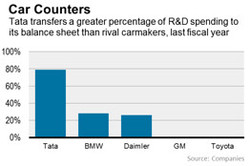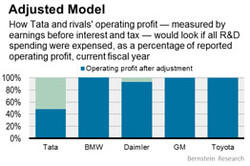
India's Tata Motors highlights importance of comparing accounting standards when comparing companies.
Tata accounts for research and development costs differently than peers in a way which boosts profit in the near term. If comparing P/E ratios, this actually makes Tata more expensive than initially appears.
Tata's R&D program, at 6% of sales, is higher than 4%-5% global car makers typically spend on new products and designs.

Tata capitalized roughly 80% of R&D activity fiscal year 2012/13.
Indian SUV-maker Mahindra & Mahindra capitalized 44% of R&D.
American and Japanese car makers expense all R&D spending, as local accounting rules require.
German auto makers, who report under international accounting standards, can capitalize R&D, though this has averaged only a third at BMW last 5 years.
Tata may need more R&D than BMW and Mahindra.
Tata says has followed this practice for years, meaning it isn't changing course.
Net effect of Tata's R&D accounting is to bolster the bottom line. If all R&D spending were expensed, Tata's net profit would fall by 2/3rds, estimates Bernstein Research. Damlier's earnings would decreases by -10%. BMW's earnings would be boosted +1% since it amortizes older R&D spending and bears expense on income statement.
Adjusting for R&D this way, Tata's P/E valuation ratio increases from 9.6x to 28x earnings. Valuations at Daimler and BMW come in at 11.3x and 10.1x, after the same adjustments.
Source: http://online.wsj.com/news/articles/SB10001424052702303789604579199210852043816
CKB Solutions is all about real solutions for the real world. To learn how we can help your business, contact Greg Kovacic in Hong Kong.


 RSS Feed
RSS Feed
